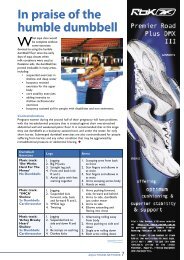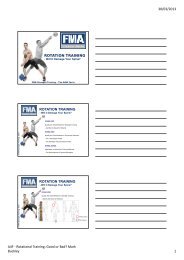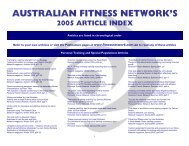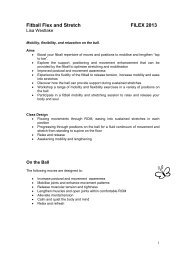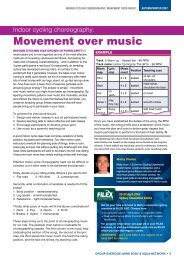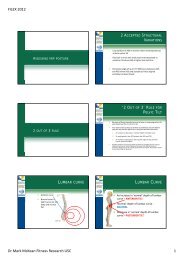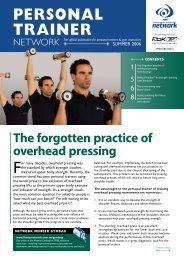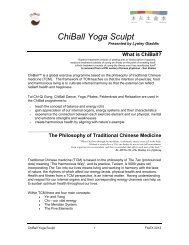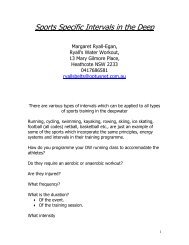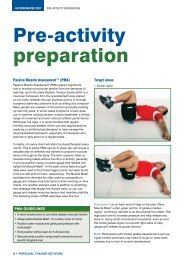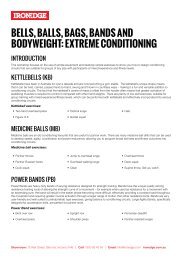CD - Australian Fitness Network
CD - Australian Fitness Network
CD - Australian Fitness Network
Create successful ePaper yourself
Turn your PDF publications into a flip-book with our unique Google optimized e-Paper software.
AUTHOR’S BIO<br />
NUTRITION<br />
MAXIMISE<br />
NUTRITIONAL BENEFITS WITH THE<br />
COHESIVE FOOD STRATEGY<br />
Teresa Doherty<br />
Teresa is a nutrition expert with over 16 years’ experience in the health and fi tness industry. She has worked as a freelance nutritional therapist and<br />
fi tness instructor, as well as a college lecturer and assessor. She is also the founder of Green Apple Nutrition, offering solutions for a healthy diet<br />
and positive mental attitude (www.greenapplenutrition.co.uk)<br />
�Did you know that eating certain foods in<br />
combination can enhance their nutritional value?<br />
Foods and their nutrients work together as a cohesive<br />
dynamic team where they enhance or reduce another’s nutrients<br />
action. Some nutrients remain passive until another nutrient<br />
has made them active and some inhibit or promote absorption;<br />
along with this, there are probably hundreds of plant chemicals<br />
whose functions are yet to be discovered. Here are some of the<br />
ways you can achieve food synergy.<br />
Calcium is the most abundant mineral in the body:<br />
the contraction of muscles, release of neurotransmitters,<br />
regulation of heartbeat and clotting of blood all rely on<br />
adequate calcium absorption. Calcium interacts with a<br />
number of minerals, but it best functions in combination<br />
with magnesium – although an imbalance in one can aff ect<br />
absorption and metabolism of the other.<br />
Vitamin C from food has more value than from<br />
supplements – research has shown that ascorbic acid from<br />
natural citrus extract, containing biofl avonoids, proteins<br />
and carbohydrates, is more slowly absorbed and more<br />
bioavailable (able to reach the body’s circulation) than<br />
synthetic ascorbic acid from supplementation. The eff ects of<br />
grapefruit juice are complex and have been widely studied<br />
– it provides good levels of vitamin C and helps to protect<br />
against cardiovascular disease and cancers.<br />
Research has found it<br />
to be an inhibitor of the<br />
intestinal enzyme<br />
system P-450, which<br />
is responsible for<br />
the metabolism<br />
of many drugs.<br />
The coingestion<br />
of grapefruit juice<br />
38 NETWORK WINTER 2010 www.fitnessnetwork.com.au<br />
with drugs such as diazepam, simvastatin and prednisolone<br />
increases their bioavailability and therefore their side eff ects.<br />
For this reason, grapefruit juice ingestion should be avoided<br />
with certain drugs.<br />
Iron is critical for human life. It plays a central role in<br />
the formation of the haemoglobin molecule in red blood<br />
cells, where it functions in oxygen and carbon dioxide<br />
transportation. Iron also functions in several key enzymes in<br />
energy production and metabolism.<br />
Dietary iron is available from two distinct forms: ‘haem’<br />
iron, which is bound to haemoglobin and myoglobin in<br />
animal products (effi ciently absorbed) and ‘non-haem’ iron,<br />
which is found in plant food (poorly absorbed). It has been<br />
reported that the absorption of iron from rice was only one<br />
per cent and 1.3 per cent from spinach. It appears that the<br />
phytic acid in grains and the oxalic acid found in vegetables<br />
bind to the iron and reduce its absorption.<br />
Vitamin C has been shown to optimise absorption of<br />
dietary non-haem iron by keeping it in its ferrous condition.<br />
Research has shown that the iron of maize, rice or black beans,<br />
which is normally poorly absorbed, was used<br />
2 to 3.5 times better when vitamin-Crich<br />
caulifl ower was added to the<br />
meal. Further studies showed<br />
that adding 150g of papaya<br />
containing 66mg of vitamin<br />
C increased iron absorption<br />
fi ve-fold. The amino acid<br />
cysteine binds to the iron<br />
and infl uences absorption<br />
up to two-fold by carrying it<br />
across the intestinal membrane.<br />
Good sources of cysteine are onions, garlic,<br />
oats, wheatgerm, broccoli and Brussels sprouts.



